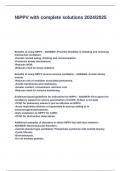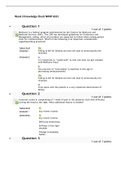Samenvatting
2023/2024 Summary 3.5 Memory - Theme 6 & 7
- Instelling
- Erasmus Universiteit Rotterdam (EUR)
This is a summary of Theme 6 & 7: Implicit Memory & Skill Learning / Consolidation & Forgetting (3.5C Memory). It contains all the literature including graphics that can help you understand! My grade: 8.3 Average grade: 6.2
[Meer zien]













